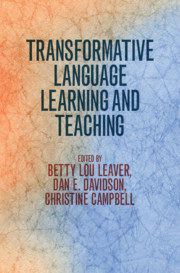Book contents
- Transformative Language Learning and Teaching
- Transformative Language Learning and Teaching
- Copyright page
- Contents
- Figures
- Tables
- Contributors
- Foreword
- Acknowledgments
- Abbreviations
- 1 Introduction
- Part I Theoretical Framework
- Part II Transformative Language Learning and Teaching Applications in Government Programs
- 5 Open Architecture Curricular Design
- 6 Foreign Language Learning Efficiency
- 7 The Challenges of Implementing Transformative Pedagogy
- Part III Transformative Language Learning and Teaching Applications in University Programs
- Part IV Transformative Language Learning and Teaching Applications in Immersion Programs
- Part V The Learner
- Part VI Faculty Development
- Part VII Assessment
- References
- Index
6 - Foreign Language Learning Efficiency
Transformative Learning in an Outcomes-Based Environment
from Part II - Transformative Language Learning and Teaching Applications in Government Programs
Published online by Cambridge University Press: 26 January 2021
- Transformative Language Learning and Teaching
- Transformative Language Learning and Teaching
- Copyright page
- Contents
- Figures
- Tables
- Contributors
- Foreword
- Acknowledgments
- Abbreviations
- 1 Introduction
- Part I Theoretical Framework
- Part II Transformative Language Learning and Teaching Applications in Government Programs
- 5 Open Architecture Curricular Design
- 6 Foreign Language Learning Efficiency
- 7 The Challenges of Implementing Transformative Pedagogy
- Part III Transformative Language Learning and Teaching Applications in University Programs
- Part IV Transformative Language Learning and Teaching Applications in Immersion Programs
- Part V The Learner
- Part VI Faculty Development
- Part VII Assessment
- References
- Index
Summary
L2 learning today is increasingly outcomes-based, and demands learning efficiency. This chapter describes the design and implementation of transformative open architecture curricula to meet two challenges that arose during 2012-2014 at the Defense Language Institute Foreign Language Center (DLIFLC). The requirement was to achieve measurable proficiency growth (≥ .5 ILR level) for students entering with proficiency between ILR 1+ and 2+ in shorter time frames than previously considered feasible. The approach had to be applicable for all DLIFLC languages and allow courses to be brought online quickly and modified continually. The response employed a modular content-based and scenario-based structure. In place of linear scope and sequence, “vertical spiraling” was employed. Integration of activities was ensured through culminating scenarios, toward which all module activities were directed. Collaborative learning was ensured in part through initial negotiation that also enhanced learner empowerment, ensuring students could mentally map out learning needed in preparation for the culminating activity. Proficiency gains exceeding objectives were often achieved in as little as 6-8 weeks.
Keywords
- Type
- Chapter
- Information
- Transformative Language Learning and Teaching , pp. 51 - 60Publisher: Cambridge University PressPrint publication year: 2021

